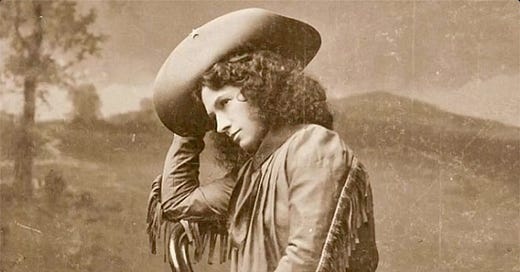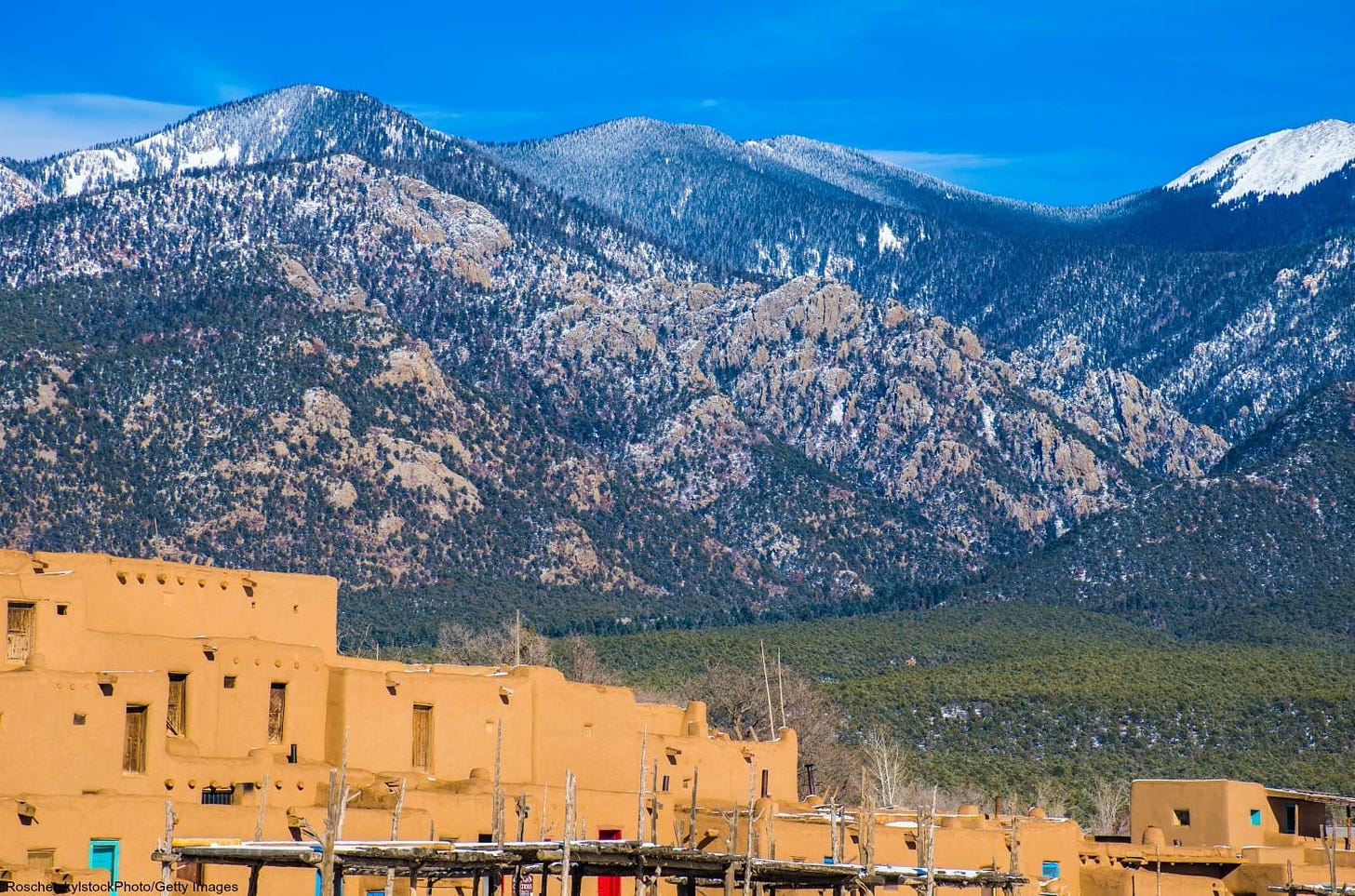I’ve decided this week to write about a subject almost as dear to my heart as art and the art world: myself. As those of you who followed “Eat My Memoir” know, I reached a point where I couldn’t go on writing that particular history. I stopped the narrative shortly before we moved to San Francisco: I was fortyish, my marriage was at the breaking point, and it didn’t seem fair to write about a man who is now struggling with dementia.
But so much, of course, has happened since circa 1991 (divorce, horrible romances, a cross-country move to Seattle, a failed radio show, travels all over the place), but what I want to share with you today is how I ended up in Taos, NM, about 14 years ago. Me, a diehard urbanite since high-school days, transported to this tiny mountain town (population 6.400) where so many go in search of spiritual enlightenment or off-the-grid living.
My excuse was simpler: I couldn’t afford New York anymore on a freelance art writer’s pitiful wages. I was always gainfully employed, usually by ARTnews and The Wall Street Journal, but that doesn’t translate into the sort of lifestyle Carrie Bradshaw, another urban freelancer, seems to maintain without so much as a bounced check or a chipped fingernail. In the winter of 2011, I was looking at a 500-dollar rent hike on my adorable one-bedroom near Grand Central, and other rental prospects seemed pretty grim. It was either find a studio apartment in Red Hook or get the hell out of town.
I had visited my ex-husband in Taos a few times before committing (we used to have that sort of friendly helpful relationship), and thought, I can handle this! Living here might be a real trip. And so it was that I moved into a small three-bedroom house on the south side of town, with a bonkers landlady who was in over her head for the mortgage on her ayurvedic healing hut (don’t ask) and so was renting out her main house for a year.
But that’s a very long aside we will save for a later date. Instead allow me to share a couple of anecdotes from my first few months in Taos.
When I arrive at a new place—whether it’s a town, an office, a party full of strangers—I have the feeling I come across like a big friendly Labrador retriever, tail wagging, tongue slurping, eager to be loved by one and all. I go out of my way to be pleasant and accommodating, which can get me in all sorts of trouble. And yet it seemed people in Taos were in fact eager to meet me, because news does travel fast in a small town. Whereas in New York I was just one of scores of art journalists (or culture reporters) who write for major publications, here the WSJ and ARTnews seemed to carry a clout I would associate more with The New Yorker or maybe “60 Minutes.” It was a fleeting fame, of course, but I enjoyed it while it lasted.
Among the first acquaintances I made was the neighbor of a woman who was dating my ex, a Harvard-educated, faintly patrician guy named Dick, who did not interest me in any way romantically but who provided a nostalgic tie to my home turf on the East Coast. He has since moved back to New York, but he was then living in a part of Taos the natives call “Anglo Heights,” a couple of miles east of the historic district. In any other part of the world, this would probably be a gated community, an enclave of upscale adobes set among pine trees and gravel roads, largely hidden from view. Dick’s house was built around a garden courtyard, and filled with the kind of furnishings and pictures appropriate for a former director of a decorative arts museum. I went to a few dinner parties chez lui, and though he was single, he was most decidedly not my type. Even if I am East Coast born and bred, I just can’t warm up to the Bermuda-shorts-and-tasseled-Weejuns look.
And I didn’t discern that he had much interest in me. But we found enough in common for good conversation and one balmy summer night, met at a local bar and grill to eat outside, behind the historic tchotchke-choked shopping mall known as The Plaza. We took a table on the upper terrace, ordered margaritas, and quickly discovered we were both distant friends of an art historian who divides his time between an apartment in Florence and a teaching job in Virginia—John Spike, who wrote a biography of Michelangelo, which I reviewed for ARTnews; Dick went to grad school with him way back when. We fell to discussing what a gracious man he is and what a fine writer and what interesting details he uncovered about the young genius’s early life.
Suddenly, violently, the chair behind Dick screeched against the stone floor, and a 30-ish muscle-bound guy in a baseball cap careened away from the table toward the main dining room. The woman he was with looked visibly pained, almost to the point of tears. I wondered if they’d had a bad fight, and because I could see her face clearly, I caught her eye and silently mouthed, “Do you need help?” She shook her head no.
When he returned, her date was fuming, directing his invective toward us. “Why can’t you guys talk about something important? Why can’t you talk about the Red Sox, fuh chrissakes?”
Dick’s eyebrows lifted above his horn rims. “Welcome to Taos.”
We asked the waiter to move us to a table inside.
Later that night, I called my ex. “What the hell am I doing in this one-horse town?”
“Ann,” he replied calmly. “It’s a two-horse town.”
I fared somewhat better in studio visits, not knowing which might ripen into friendships, but it seemed a good way to get to know the lay of the land and the many excellent artists who call this place home. But occasionally the puppy-dog eagerness can backfire. After I returned from a press trip to Los Angeles to survey the offerings of a gigantic multi-institutional overview of West Coast art since 1945, I phoned one of the “star” artists who had migrated to Taos in the 1970s to express heartfelt admiration for the work I saw at one of the museums. I identified myself and suggested a studio visit. Which inspired him to launch into a 10-minute tirade about how the New York critics had all ignored him most of his career and had no understanding of his rightful place in the contemporary pantheon. Nor did they know much about contemporary art. Nor would I understand the kind of work he was doing then….and where the fuck did I get off thinking I could just drop by? I was told later by local art dealers that when he’s off his meds, he can be truly frightening. I never did make a studio visit, because he scared the bejesus out of me.
Regrettably, in spite of a number of inventive artists in Taos and its environs, the art scene here remains depressingly lackluster (it’s one of the reasons I started the short-lived Wright Contemporary). The museum is a mixed bag of provincial and head-scratchingly ambitious (and a fine auditorium languishes for lack of programming), most galleries adhere to a gift-shop aesthetic, and the one dominant group of abstract artists stages shows that look like graduation night at the Art Students’ League.
But that’s obviously not what keeps me in Taos. Even though I have my moments, cruising toward town on the main drag—past the gas stations and Walmart and the cannabis shops and the ugly strip malls—when I pound the steering wheel and swear: “How the hell did I wind up here? Am I being punished?”
In spite of all that, there are too many reasons to stay, even if I had the opportunity to pull up stakes one last time. The climate is by and large benign, the landscape is mysterious and ravishing, and in the 14 years since I arrived, I’ve made better friends than I ever had in decades of living in New York.
Plus Sylvia loves it here.
And that’s more than plenty.









I have a cousin who lives in Taos and he has never been happier. Thanks for you story about your life there. I will never leave NYC, not because I don't want to, but if I could, I would head to Taos with no second thoughts!
Having lived a bit north of Taos in the early 1970s, I still think of it as one of the most beautiful, magnetic places ever. Sylvia is right.